It's always amazing to me that My Mom can just whip up a pan of biscuits. Although I'm more-than-proficient in the kitchen, doing bicuits well are beyond me without my old standby, Bisquick.
Grace has tried to show me how to make them.
Should be simple; but I just don't have a feel for them, no instinct and no patience for repaeated failure.
...but, sometimes nothing compliments a dish like a a nice basket of bicuits.
After Friend Betsy asked me (her "Chef") for a recipe (and my confessing the shortcoming to her), we tried three "from scratch" recipes. This one worked well and is going to be our standard.
Bisquick is still in the cupboard.
Most biscuit recipes are variations on the same theme: flour, fat, milk or buttermilk, baking powder, and salt. It's how the ingredients are put together that really matters.Bisquick is still in the cupboard.
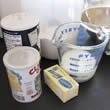 |
|
Cutting in the fat
You can use your hands or a food processor to cut the butter into the flour mixture, but I like using a pastry blender. It's a very low-tech tool that kind of resembles four curved dull blades attached to a handle. Unlike pie dough, you don't need to use ice-cold ingredients to make biscuits--another reason why they're quick to make.
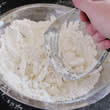 |
Crumbly dry mix
The recipe states, "Cut in shortening with fork or pastry blender until mixture resembles coarse crumbs." You want to have a fairly homogenous mixture, rather than having large flakes of butter visible in the flour. If you squeeze some of the flour-fat mixture in your hands, it'll form a ball.
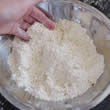 |
Sticky wet mix
After adding the milk (or soured milk, or buttermilk, or half plain yogurt and half milk stirred together), mix the dough just until it's combined. You don't want to overwork it.
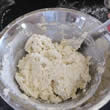 |
On the work surface
Turn the dough out onto a floured surface and dust the dough with flour, too. At this point, you're going to do a little quick kneading--not enough to form a tough gluten structure, but enough to work some flour into the dough and help form layers in your flaky biscuits.
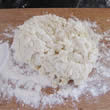 |
Folding the dough
Pat the dough flat, sprinkle it with a little more flour, and fold it in half. Turn the dough 45 degrees, and give it another sprinkle of flour and a fold. Repeat once or twice more.
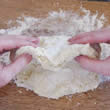 |
...And patting it out
I don't bother with a rolling pin; I just give the dough a couple of pats until it's about a half-inch thick.
Now, here's the important step: You need to use a biscuit cutter, a sharp knife, or a pizza wheel to cut your biscuits. (A jelly jar or juice glass is just too dull; part of what makes biscuits puff up as they bake is the sharp, clean edges of the dough.)
Arrange the biscuits on a baking sheet. Gather up your scraps, gently squeeze them into a ball, and pat the dough flat again to cut out more biscuits.
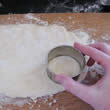 |
Brush with milk
I like to brush the surface of the biscuits with milk or egg wash before baking, for a little deeper color.
- Bake the biscuits in a hot oven until the bottoms, not the tops, are a golden brown--if you rely on the color of the tops of the biscuits, they're likely to get too dark.
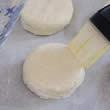 |

No comments:
Post a Comment